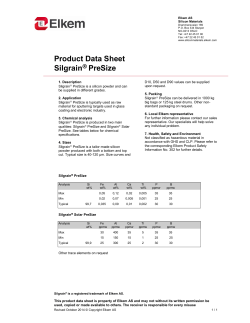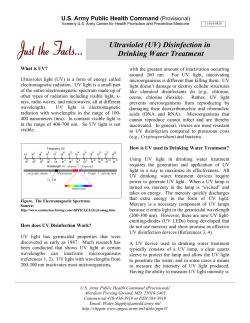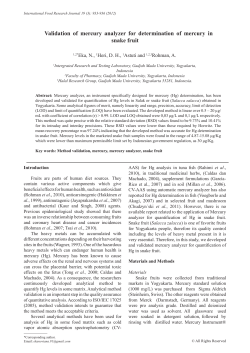
How to Treat Refinery Gases And Make Them Suitable to
How to Treat Refinery Gases And Make Them Suitable to Recover Valuable Liquids Presented by: Zaheer I. Malik, BS, MS, Chemical Engineering. Principal Process Engineer John W. Slack, PE. Sales Manager Linde Process Plants, Inc. Tulsa, Oklahoma How to Treat Refinery Gases And Make Them Suitable to Recover Valuable Liquids ABSTRACT Refinery Fuel Systems are generally a mixture of Gases coming from several different units within the refinery. The quantity and quality of gases in the fuel system depends on refining capacity, severity of cracking unit and the quality of refinery crude. Some US refineries are long on fuel and this excess fuel is flared. Despite being flared, this fuel gas contains several valuable components like hydrogen, ethylene, propylene, propane and higher olefins. These components can be recovered economically from the fuel gas. By not flaring these components, Refineries reduce their emissions and contribute to the margins. This paper addresses how to treat refinery gas to meet the product specifications for the polymer grade ethylene and propylene. This paper also address how each contaminant is removed from the fuel gas, the reason for its removal, the chemistry and engineering involved If the desired recovery is C3+ components then minimal treatment of the fuel gas is required (Amine and Dehydration), however if C2+ recovery is desired, treatment requirement become complex and expensive. Regardless, the treating strategy must address Product Specifications and Safety. 2 Introduction Refinery off-gas (ROG) comes from a variety of units within the refinery. The quality and quantity of the ROG is dependent on the type of crude and the complexity of the refining. The majority of the fuel gas stream is generated In Fluidized Catalytic Cracking Unit (FCC) where the long chain hydrocarbon molecules are broken into lower molecular chains or lighter hydrocarbon components. Significant amounts of olefins are also produced during hydro-treating. These olefins are valuable and can increase revenue. Often the refinery off-gas also contains a large amount of hydrogen that, if recovered, can provide economic value. Hydrogen can be recovered either utilizing pressure swing adsorption (PSA) or cryogenic process. Table I illustrates the range compositions of the ROG components. Table II reflects the refinery gases contaminants. Several of the contaminants have to be removed from the feed gases, either to meet product specifications (shown in Table III) or to mitigate the operational hazards. After removing the hydrocarbon liquids the residual gases are an excellent feed stock for a hydrogen plant utilizing steam methane reforming technology. In order to prepare the gases for ethylene liquids recovery the following contaminants must be removed in order to meet the product specification listed in Table III trough VII. 1. 2. 3. 4. 5. 6. 7. Hydrogen Sulfide (H2S) and Carbon Dioxide (CO2) Ammonia Chlorides Water Mercury Carbonyl Sulfide ( COS ) Arsine 3 8. 9. 10. Acetylene NO, NO2, NOx (Nitro Gum) Dienes ( 1-3 butadiene , acetylene , propadiene etc. ) The composition of the ROG gas depends on the type of crude, the cracking severity and type of catalyst used for cracking. Typically, range of components in the FCC gas is listed below in Table I the trace components are listed in Table II : Table I Typical FCC off-gas Composition Component Mol % Hydrogen 10-50 Carbon Monoxide 0.1-1 Nitrogen 2-10 Methane 30-55 Ethylene 5-18 Ethane 15-20 Propylene 1-6 Propane 1-6 Butadiene 0-0.15 Butylene 0.1-0.5 Iso & N-Butane 0.5-1 C5+ 0.2-2 Before a treating system can be designed, several trace components must be properly analyzed. These components are listed in Table II below. There are several laboratories around the U.S. that can analyze these components accurately. The concentration of the components shown in Table II is dependent on refinery complexity and type of the crude. 4 Table II Refining off-gas Contaminants its Method of Analysis and Expected Concentration Component Hydrogen Sulfide Carbon Disulfide Sulfur Dioxide Methyl Mercaptan Ethyl Mercaptan Propyl Mercaptan Dimethyl Disulfide Methyl Sulfide Carbonyl Sulfide Preferred method of Analysis Titrator Titrator Mass Spec Titrator Titrator Titrator Titrator Titrator Chromatograph Detector Tube Available? Yes Yes Yes Yes No No No No Yes Other Mercaptans Carbon Dioxide Ammonia Titrator Chromatograph Chromatograph Yes Yes Yes Arsine Mass Spec Yes Expected Concentration 25 ppmv 1 ppmv 1 ppmv 700 ppmv 120 ppmv 50 ppmv 10 ppmv 5 ppmv 50 ppmv 50 ppmv (Total mercaptan test) 400 ppmv 500 ppmv 1 ppmv (normally in ppb range) Trace < 500 ppmv Trace 10 ppmv 200 ppmv < 1mole percent < 1mole percent < 1mole percent < 1mole percent < 1mole percent < 1mole percent < 1mole percent < 100 ppmv < 500 ppmv < 500 ppmv < 1mole percent < 1mole percent 120 ppmv 50 ppmv 100 ppmv 100 ppmv Unknown < 500 ppmv Acetylene Chromatograph Yes Methyl-Acetylene Chromatograph No Mercury ( all forms ) Altec Absorption Method Yes Lead Mass Spec No Propadiene Chromatograph No Butenes (2) Chromatograph No Butadiene Chromatograph No Pentadiene Chromatograph No Benzene Chromatograph Yes Toluene Chromatograph Yes Xylenes Chromatograph Yes Hydrogen Cyanide Mass Spec Yes Nitric Oxide Mass Spec Yes Nitrogen Dioxide Mass Spec Yes Oxygen Chromatograph Yes Carbon Monoxide Chromatograph Yes Methyl Acetate Mass Spec No Alcohols Mass Spec Yes Aldehydes Mass Spec No Ketones Mass Spec Yes (acetone) Bitumen Unknown No Amines Mass Spec Yes Notes: 1. Mercaptans heavier than propyl and can be grouped as total mercaptans 2.The butene analysis should be specific for N-Butene, Isobutene, Trans-2-Butene, Cis-2-Butene, 2Methyl-1-Butene, 2-Methyl-2 Butene, 3-Methyl-1-Butene 3. The above compounds are contaminants from a product specification viewpoint. Other compounds such as Hydrogen Sulfide, Carbon Dioxide, Mercury, Butadienes, Pentadienes, Nitric Oxide and Oxygen also have a potentially negative affect from a safety or equipment viewpoint. Therefore, these components must be identified regardless of the product specifications. 5 4. Sodium, Chlorides and Fluorides may be present in trace quantities The prospective products of the refinery liquid recovery units are: 1. 2. 3. 4. 5. 6. 7. Ethylene Ethane Ethylene/Ethane Mix Propylene Propane Gasoline or C5+ Residue Gas or Fuel Gas The product specification is dependent on the market requirement for product sales. Table III below lists typical product specifications for a chemical and polymer grade ethylene. Table III Typical Ethylene Product Specifications Chemical Polymer Grade Grade No Composition 1 a. Ethylene, minimum, mol % 99.5 99.85 b. Ethane, maximum, ppmv 1,000 400 c. Propane, maximum -- -- d. Propylene, maximum, ppm-mol 10 10 e. Carbon Dioxide 50 ppmv 5 ppmv f. Methane, maximum 500 ppmv 0.15% by vol g. Acetylene, maximum 5 ppmv 5 ppmw h. Moisture, maximum 2 1 ppmv i. Ammonia, maximum, ppbw 10 0.5 to 1 j. Carbon Monoxide, maximum ppmv 10 0.5 k. Carbonyls, maximum, ppmw -- 5 l. Hydrogen, maximum, ppmv -- 1 m. Methanol, maximum, ppmv -- 5 n. Oxygen, maximum, ppmv 20 5 o. Total Sulfur, maximum, ppmw -- 1 p. Total Chlorides, ppmv -- 1 Copper strip at 100 F No. 1 -- 3 Volatile Sulfur, ppmv 10 4 Water Content, maximum, ppmv 10 2 Corrosiveness 6 0.5 to 10 Ethane sold as an ethylene cracker feed stock must meet certain purification .Table IV below lists typical specifications for the ethane minimum feed stock: Table IV Ethane Product Specifications No 1 2 Specification Composition a. Ethane, maximum, mol % b. Carbon Dioxide, ppmw c. Methane, maximum d. Ethylene, maximum, ppmw e. Propane Plus, maximum f. Acetylene, maximum, ppmw g. Olefins, maximum, ppmw h. Aromatics, maximum, ppmw i. Ammonia, maximum, ppbw k. Arsine, ppmw l. Phosphene, ppmw Corrosiveness Field Grade Cracker Feed 95 500 3.0 mol % NA 3.5 mol % NA NA NA 1 10 10 No. 1 99 1 150 ppmw 1 1 ppmw 1 1 1 1 10 10 No. 1 Propylene may be sold as chemical, refining and polymer grade. Propylene is separated from propane using C3 splitter fractionation. Table V below lists chemical and refining grade while Table VI given below gives a polymer grade product specification. Table V Chemical and Refining Grade Propylene Product Specifications No 1 2 3 4 Specification Composition a. Propylene, minimum, LV % b. Carbon Dioxide, ppmw c. Methane, Ethylene, Ethane, maximum, LV% d. Propane, maximum, mol % e. Butanes, Butenes LV % Corrosiveness Copper strip at 100 F Volatile Sulfur, ppmw Dryness 7 Chemical Grade Refining Grade 99.5 1 0.5 0.5 60-65 No. 1 185 No water 1.5-2.25 Remaining 0.5-1.00 No water Table VI Polymer-Grade Propylene Production Specifications Component Propylene Propane Hydrogen Methane + Ethane Ethylene Acetylene Methyl Acetylene Propadiene 1,3 Butadiene Butanes + Butylenes Water Oxygen Methanol Carbon Monoxide Carbon Dioxide Arsine Carbonyl Sulfide (COS) Elemental Sulfur Unit of Measure wt % wt % wppm Export Spec 99.5 min 0.4 max 1 max PPBW Spec 99.45 min 0.55 max 1 max wppm wppm wppm 200 max 10 max 1 max 350 max 10 max 1 max wppm wppm 1 max 1 max 1 max 1 max wppm 1 max 1 max wppm wppm wppm wppm 10 max 2 max 1 max 1 max 10 max 2 max 1 max 1 max wppm 1 max 3 max wppm wppb 3 max 20 max 5 max 20 max wppb 20 max 20 max wppb 500 max 500 max Table VII below gives a HD-5 grade propane specification. Table VII HD 5 Grade Propane Specifications No 1 2 3 4 5 Specification Composition a. Propane minimum, Liquid vol % b. Butane and heavier, Liquid vol % c. Pentanes and heavier d. Temperature at 95% evaporation, °F Vapor Pressure at 100 °F, max Corrosiveness Copper strip at 100 °F Volatile Sulfur, ppmw Dryness 8 HD-5 Grade 90 2.5 None -37 208 psig No. 1 185 No water CONTAMINANT REMOVAL A. Mercury Removal Mercury is present in natural gas, natural gas associated condensates and in refinery off gases, as organometallic and inorganic compounds, and in the elemental (metallic) form depending on the gas source. The elemental form can be found in either the vapor or liquid phase. The organometallic (typically dimethyl mercury, methylethyl mercury, or diethyl mercury) and in an inorganic form (such as HgCl2) mercury condense into the liquid phase in any hydrocarbon fractionation column. Vapor-phase elemental mercury is a primary source of corrosion in aluminum heat exchangers. Elemental mercury that leaves the plant with the hydrocarbon liquid streams is a primary source of corrosion for the aluminum equipment in olefins liquid recovery plants. Mercury also poisons the selective hydrogenation catalysts in olefin plants, and can pose inhalation hazards to workers. The organometallic and inorganic forms mercury usually ends up in the condensate stream from the natural gas or refinery liquid recovery plant. These compounds are important environmental toxins that are easily absorbed and accumulated by biological organisms. The presence of these compounds in gas condensate streams leads to waste disposal problems and safety hazards to workers. Although relatively high levels of elemental mercury were discovered in the Groningen (Holland) field as early as 1969, the first recorded cold box failure attributed to mercury corrosion was in the aluminum spiral wound heat exchanger of the LNG plant at Skikda, Algeria, 1 in 1974. Since this time, mercury in natural gas has become a major concern in cryogenic gas processing industries. These industries, or refinery gases including liquefied natural gas (LNG), liquefied petroleum gases (LPG), and olefins recovery, often use Brazed aluminum heat exchangers in their cold boxes. Mercury corrosion of aluminum exchangers has led to several additional failures since the problems at Skikda. In addition, mercury accumulation can lead to poisoning of catalysts used in olefin processes, personnel safety hazards, and waste disposal difficulties 9 Mercury Sources Elemental mercury is a natural contaminant present in the produced natural gas in various concentrations at certain geographic locations. The concentration of elemental mercury in the gas stream is often expressed in μg/Nm3, which is a very small number. Generally speaking, elemental mercury levels have been found to be the highest in Southeast Asian gases (up to 400 μg/Nm3 in the vapor phase) and lowest in United States Gulf Coast gases ( as low as 0.02 μg/Nm3 ), although wide variation is known to occur even within local regions. However, even at the very lowest natural concentrations it is still desirable to reduce the amount of mercury before any cryogenic processing, either in refinery or natural gas streams. The Mercury can accumulate to higher concentrations over time. The mechanism for the formation of organometallic mercury is not known. Current theory suggest that elemental mercury may react with the walls of reboilers and catalytic furnaces to form active species which can then react with methane, ethane, ethylene, the products of a ROG Gases, and other organic compounds. How to Remove Mercury Mercury is removed from LPG plants to protect the aluminum heat exchangers from corrosion. Sulfur-impregnated activated carbon is used to remove mercury from the gaseous hydrocarbon feed stock. Mercury removal by the activated carbon is much more efficient if the moisture is not present or removed from the stream before coming in contact with activated carbon. The maximum attainable mercury concentration in the treated gas stream is not pressure dependent. A typical mercury removal system is shown in Figure 1. 10 Feed Gas Treated Gas Figure I Typical Mercury Removal System The mercury removal process can be a single or dual bed adsorption system. The system can be designed to reduce mercury to a concentration of < 0.01 μg/Nm3. The chemical reaction converts the mercury to mercuric sulfide. The sulfide product is then retained in the pores of the carbon granules. The mercury capacity of the activated carbon can be 15-20% by weight. Activated Carbon Specification Approximately 37 lb/ft3 10% Density, Sulfur content by Weight B. Arsine The presence of an arsine compound (AsH3) in a hydrocarbon stream may act as a poison for the selective hydrogenation catalyst. The presence of arsine is a specific problem in C2 splitter column since its boiling point is between ethane (C2) and ethylene (C2 =) it tends to build up in the column without leaving either with overhead or bottoms product. Arsine is generally present in the refinery gases in the concentration of less than 1ppm . This small quantity is enough to poison the selective hydrogenation catalyst. 11 A sacrificial bed either filled with ZnO or CuO material is use to retain arsine (AsH3). Arsine removal material is available from several different catalyst suppliers. C. COS (Carbonyl Sulfide) Traditional treating with caustic or amine solution is not effective in removing COS (carbonyl sulfide) from a hydrocarbon stream. COS can be removed from the refinery off gases by the following two ways: 1. COS removal by hydrolysis 2. COS removal by adsorption ( in our opinion this is a better approach ) COS Removal by Hydrolysis There are several catalysts available to hydrolysis the COS into H2S and CO2 by the following reaction. COS + H2O CO2 + H2S Some catalysts perform both the hydrolysis of COS to the reaction products H2S plus CO2 and the subsequent retention of both these acidic compounds (H2S and CO2) These catalysts may be used for the purification of either liquid or gas streams. The stream to be purified must contain equibrium water (typically 300 ppmw) but must not contain free water which would destroy the material. These catalysts do not require activation before use. Typical operating conditions for hydrolysis catalyst are. Temperature ----------------------------------------100-250°F Pressure ----------------------------------------------150-440 psig COS Removal by Adsorption The COS removal by adsorption is done on the dry feed gas. The system is very similar to a molecular Sieve dehydration system. Two beds with switching valves are 12 installed one bed is in adsorption mode while the other is regenerated and cooled. The system usually has a cycle time of 168 hours (one week) while the offline bed can be heated for 5 hours and cooled for 4 hours and the rest of the time is a standby time. The system requires a regeneration temperature of 550°F and generally the dry fuel gas is used to regenerate the beds. The regenerated fuel gas containing the entire COS can be returned to the refinery fuel system. A typical system is shown in the Figure II. FEED COS+ Regen Gas to Fuel Treated Gas Fig II Regenerative Type COS Removal System D. Hazards of Nitrous Oxide Accumulation in Cryogenics Olefins Recovery Units 1. Sources of The NOx Compounds NOx is found in FCC gases. NOx is produced during combustion of the coke on the FCC catalyst in the FCC regenerator. Some flue gas from the regenerator is entrained into the reactor with the recirculation catalyst, together with oxygen and nitrogen, where these light gases comingle with gases produced in the FCC reactor and is carried forward to the FCC light ends recovery units. When C2+ recovery for FCC off gases is practiced, the nitrogen, oxygen, and NOx may be Accumulated into the coldest section of the recovery facilities. Variations in FCC plant operating conditions may have a major effect on the concentration of NOx in FCC gases. 13 The design of Coker unit (relation of the regenerator-coke burner and the reactor) is similar in concept to an FCC unit. Thus, Coker gas, if fed to C2+ recovery unit, may be another source of NOx. While other sources of NOx in feeds to ethylene recovery units may exist, the only identified source is FCC gas, and by analogy, fluid coker gas. 2. Theory and Chemistry of NOx Accumulation in the Cold Train at Cryogenic Conditions While other NOx compounds exist, the principle compounds are produced by the following reaction mechanism: NO is oxidized to NO2 according to the following reaction: 2NO + O2 2NO2 (The above reaction requires excess O2 at low temperature but is a slow reaction) • Equilibrium favors formation of NO2 at low temperatures and high pressures. • Reaction rate actually increases at low temperatures. • Conversion of NO to NO2 is expected to be highest at temperatures below -100°C ( -148°F ) • NO further reacts with NO2 to N2O3 as per the following rection : NO + NO2 N2O3 (Known as (The above reaction requires cryogenic temperature and high pressure) • • N2O3 “Blue Oil” Liquid ) N2O3 accumulation is most likely to happen in the areas of the plant where the temperature is -125°C (-193 °F) or below. Upon warm up the N2O3 rapidly disassociates according to the following reaction: NO + NO2 NO2 is very toxic to humans 100 ppm exposure of NO2 can cause pulmonary edema or death. 14 NO2 Gas Collected in a Bag. The gas is Radish Brown in Color NO2 + NO2 N2O4 (The above reaction is favored at cryogenic temperature and High pressure) • • Dienes- also known as Diolefins, have two carbon-carbon double bonds. Diolefins such as 1,2-butadiene or 1,3-butadiene are most problematic Diolefins. Alkynes-is another class of unsaturated hydrocarbon, it has carboncarbon triple bond within the molecule. Examples of alkynes are acetylene, butadiene, propadiene etc. These compounds are more reactive than paraffin’s or napthenes and readily combine with other elements such as hydrogen, chlorine and bromine N2O3 + (Unsaturated Compounds like Acetylene, 1-3 butadiene and isoprene) (The above reaction is favored at cryogenic temperature) NOX/HC NOX/HC is called Nitrous Gum N2O3 + NH3 NH4NOX Salt (The above reaction is if Ammonia is present normally is washed out with caustic system) The ammonia salt is very unstable and can explode when warmed up Formation of nitrated hydrocarbons can be described below: • NO2 reacts exothermally with olefins and diolefins forming nitrated gums ( NOX gums ) • Gums of different olefins / diolefins have different decomposition temperatures. • NOX gums of conjugated diolefins form very rapidly at cryogenic temperatures. • NOX gums of conjugated diolefins are highly unstable at cryogenic temperatures. • NOX gums are soluble in cold methanol ( MeOH ) Nitrous gum at cryogenic temperatures is accumulated in the coldest sections of the plant (aluminum heat exchangers) and whenever the plant is warmed up the 15 nitrous gum decomposes at a rapid rate and is known to cause explosion and damage the equipment. A picture of the heat exchanger core damaged by such an explosion is shown below. Brazed Aluminum Exchanger core damaged due to Nitrous gum explosion. 16 Key properties of these materials and some other compounds of interest are summarized in a table VIII below which also includes a vapor pressure curve for N2O3 (2) is shown in Figure 2. Figure 2 LOG of N 2O3 Vapor Pressure VS Temperature -4 -5 LOG ( VP )-psi -6 -7 -8 -9 -1 0 -1 1 -1 2 -1 +AICHE DIPRR Data Base 3 -1 4 -1 Lange,s Chemistry Handbook 13 ed 5 -1 6 -300 -290 -280 -270 -260 -250 -240 -230 -220 -210 -200 Te mpe rature °F Table VIII Physical Properties of different NOX Compounds (2) NO Melt Point -258°F -161°C Boiling Point NO2 +15.3°F -9.3°C -240°F +69.8°F -151°C +21°C Appearance Colorless Gas RedBrow n Gas N2O3 NH4NO2 NH4NO3 -152°F -102°C +140oF +60oC (explodes) +338°F +170°C +410°F +210°C +38.3°F +3.5°C (decomposes) Blue Oil Solid white Crystals Solid Colorless Crystals • Both NO2 and N2O3 are solid at deep cryogenic temperatures. • Solubility of NO2 and N2O3 in hydrocarbons is expected to be low. • Therefore NO2 and N2O3 can freeze out and deposit in coldest section of the plant. 17 • A significant deposit of both NOx and NOx Salts has been measured in colder sections of ethylene plants. • N2O3 can also react with NH3 to Form NH3NOx salts which are also very unstable salt. Generally caustic treating followed by water wash can remove NH3 from the feed Gas. How to Reduce the Risk Posed BY NOX Gums & Salt (1) 1. Refinery off-gas contains Hydrogen and H2S. Use of Nickel sulfide catalyst (NiS) will essentially convert 100% of oxygen to H2O. Since the oxygen is an essential element in formation of the Nitro gums and salts. The risk of explosion is minimized. NiS catalyst requires the small amount of H2S to keep the catalyst active a small amount of H2S in feed take care of it. 2. One alternate to the above is to convert all the triple bond components like acetylene and dienes to their olefinic form by the use of podium catalyst. This requires an extensive feed gas treatment since any form of sulfur is poison to the polonium catalyst complete removal of all sort of sulfur is essential. 3. Another alternate is not to provide any kind of treatment but build a methanol (MeOH) wash system. Periodically when you see higher pressure drop across the cold equipment the unit is shut down for a short period of time and flushed with methanol to remove all the gums and salts because their solubility in methanol is very high. 18 Figure 6 Typical Treating Block Flow Diagram If Non Sulfurized Based Catalyst is Used. H2S & CO2 Amine Treating Feed Gas Comression If Hydrolysis Catalyst is used Trace H2S & CO2 COS Hydrolysis Water Wash Caustic Treating Water Gas Dehydration COS Removal Mercury Removal Arsine Removal Water If Regenerative Type Catalyst is Used Selective Hydrogenation Final Cooling Polishing Dehydratio Note 1 Note 1. Acetylene, 1-3 butadiene and other Triple Bond Components are Saturated to Double Bonds 19 Gas to Liquid Recovery Figure 7 Typical Treating Block Flow Diagram If Sulfurized Based Catalyst is Used. H2S & CO2 Sulufurized Catalyst Feed Gas Comression nn Water Wash Caustic Treating Amine Treating Note 1 Optional Optional Water Arsine Removal Dehydrati Mercury Removal COS Removal Water Polishing Dehydration Final Cooling Gas to Liquid Recovery Note 1. Acetylene, 1-3 butadiene and other Triple Bond Components are Saturated to Double Bonds also Oxygen is converted to Water essentially 100 % 20 The data presented in this paper is collected by the author over the years from various sources and working on different projects. Authors are also thankful to Linde and its management for providing him with the resources and dedicate his time to write this paper. REFERENCES 1. Hazards of NOx accumulation in Cryogenics Ethylene Recovery Facilities, Roy T. Hall (part of AICHE NOx Report) 2. AICHE NOx Subcommittee Report Article 15E
© Copyright 2025











